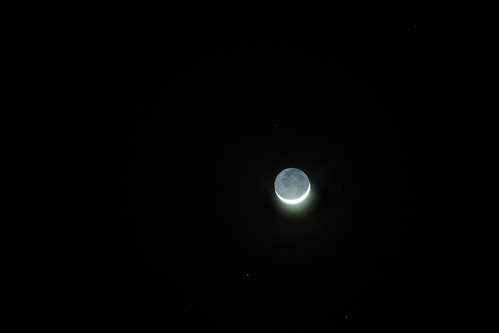Knowledge: Earthshine and the moon’s full earth
February 24, 2010
It’s attention-grabbing and serenely beautiful. Last week the early waxing slice of a young moon cradled a softly glowing, faint disk of the future full moon. I noticed it on my walk home and David burst into my library a quarter hour or so later, insisting that I should “really look at this.”
I was running late to a book club meeting, so I left David with my camera and exhortations to photograph the thing, which he did, admirably.
We know that the brightness of the moon comes from reflected sunlight, and it’s fairly well known that earthshine—sunlight reflected from the earth—can sometimes cause the night side of the moon to be faintly lit.
What hadn’t occurred to me until last week: when we have a new moon, the moon has a full earth. This is intuitively logical if you think about the alignment of things. During a new moon, the moon is lined up between the earth and the sun. That puts the side toward us in shadow, but means the moon has full exposure to the reflection of sunlight off of the earth. By the time we have a full moon, the earth is between the sun and the moon, putting the moon on earth’s darker side.
I like this idea. As the moon breathes in, the earth breathes out. Imagine how beautiful crescent earthrise must be from the moon; imagine the oddness of looking at the analogous (but reversed) delicate moonshine on the unlit portions of the earth. As we wax, the moon wanes. And the other way around.
All this is a function of albedo, a measurement of how reflective different surfaces are. Something theoretical with an albedo of 1.0 would reflect 100% of the light hitting it. The closest tangible terrestrial thing is probably fresh snow, which has an albedo between 0.8 and 0.9. The veritable black hole of surfaces, in terms of albedo, is fresh blacktop asphalt, which clocks in around 0.04, though if you dug a dark hole to China you could probably approach 0.0. The earth as a whole, being a mix of oceans, deserts, greenery, dirt, ice, rocks, clouds and humans, averages out at about 0.3. In reality earth’s albedo is constantly fluctuating because none of those things, especially the weather, are fixed.
Which means that you can look at earthshine and, if you have the right instruments, calibrations, precision and equations, track earth’s rising and falling albedo. Some scientists are using the brightness of earthshine to track possible climate change factors. According to their model, as earth becomes more cloudy—therefore trapping greenhouse gases—its albedo increases and earthshine shines brighter. On the other hand, not all of the factors in earth’s varying reflectivity over the past few decades are fully understood.
Suffice it to say, however, that if the daylight side of the earth is entirely covered in clouds on a given day, the night side is going to see brighter earthshine. Appreciably brighter? Well, sort of. But not really. If you could see both examples of earthshine: one created by an overcast day-side day versus the product of clear skies on the opposite side of the earth, if you could hold them up side by side, you’d see the difference. But without a point of comparison, the changes in brightness from month to month are not likely to be discerned by mere, puny humans.
Sources
One Comment
Recently Reviewed
Get the Books
Read my Reviews
Related Posts
- Knowledge: Tides
January 26, 2010 - Knowledge: The Great Northern Lights of 1859
February 9, 2010 - Knowledge and Travel: Pine Mountain Observatory, Messier Objects
February 16, 2010 - Photo: The Moon, by David!
November 24, 2010 - Knowledge: The year the trees stopped counting
January 20, 2010





Funny you should discuss this, of all days! In my Phy Geography class we are studying albedos and earthshine. I was amazed to learn that, technically, the Earth “shines” four times brighter than the moon. Amazing. Along the same line of thought as albedo light reflection is insolation (incoming energy) and the statistic that 35 minutes of insolation received on the US exceeds the amount of energy attained from the burning of coal, natural gas and oil in an entire year! Can you imagine if more people implimented solar energy in passive or active solar for their homes? My house has an active solar collection system and it works pretty well unless we have deep fog.
Are you collecting your essays and notes for a future journal? I really liked your essay on the aururas.